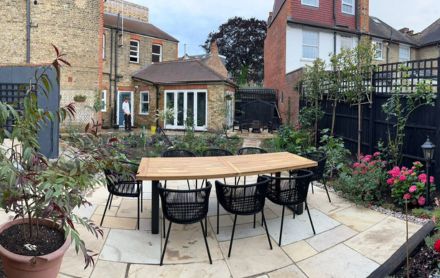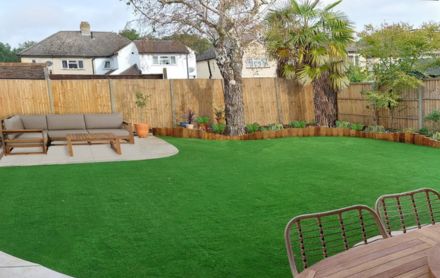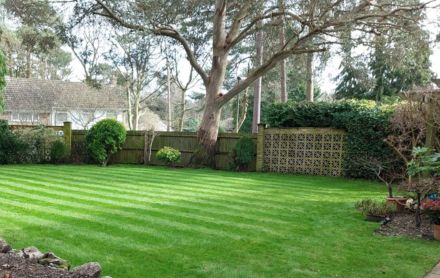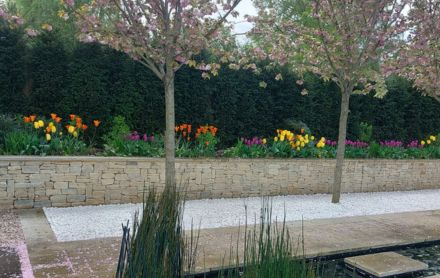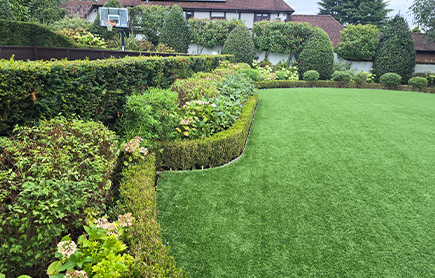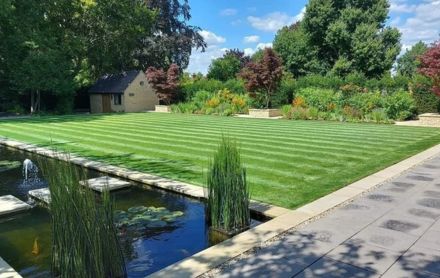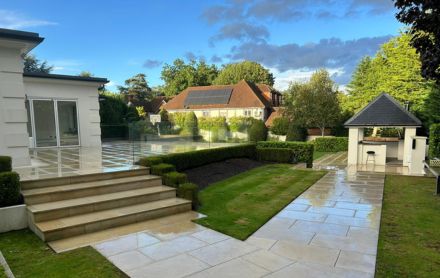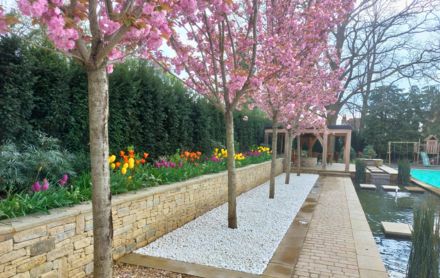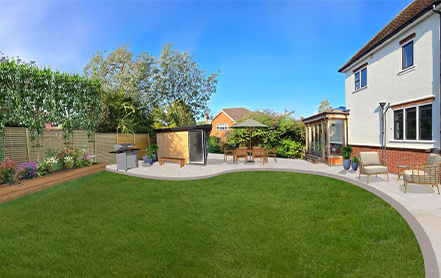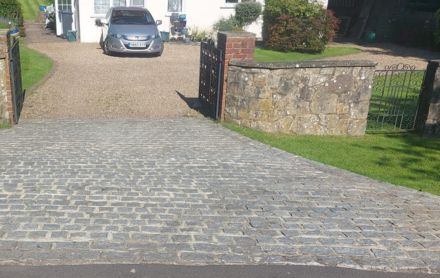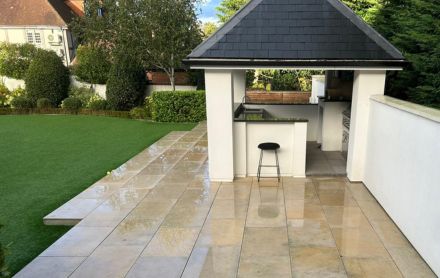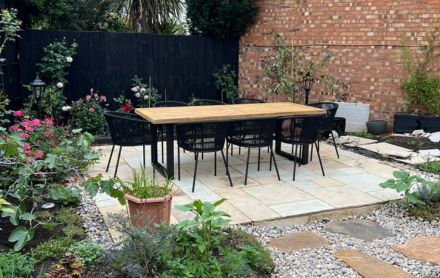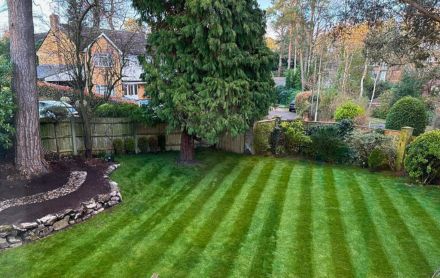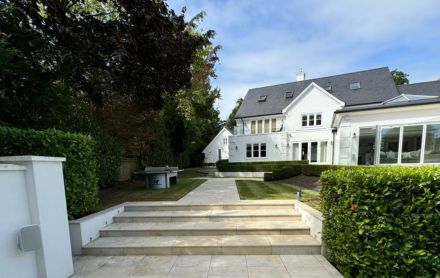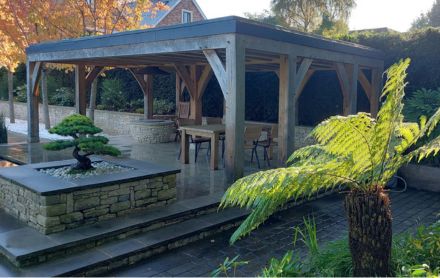Understanding Garden Design Costs In 2025
Creating your dream garden requires careful planning, creative vision, and realistic budgeting. Garden design is not only a practical discipline but also an art, requiring creativity, aesthetic judgment, and mastery of visual composition to elevate your outdoor space into a true work of art.
Garden design costs can vary dramatically depending on your aspirations, property size, and chosen features. Whether you’re planning a complete landscape transformation or simply refreshing specific areas, understanding the financial investment involved helps you make informed decisions that align with both your vision and budget.
The garden design industry has evolved significantly, with homeowners increasingly seeking professional expertise to maximise their outdoor spaces’ potential. Modern garden design combines aesthetic appeal with functionality, sustainability, and long-term value creation.
Drawing inspiration from a variety of sources and exploring innovative design ideas, such as coastal themes or planet-friendly concepts, can help shape a unique and visually appealing garden that reflects your personal style.
As a leading garden design company, Beautiful Spaces helps clients across Surrey realise their dream outdoor spaces every day. We have many years of experience in the landscaping industry and know how much garden design costs, as well as the various considerations our clients need to make.
This comprehensive guide explores everything you need to know about garden design costs, helping you navigate the investment required to transform your outdoor space into a personalised oasis.
From initial consultation fees to complete installation costs, we’ll break down each component of professional garden design services. You’ll discover factors that influence pricing, ways to optimise your budget, and understand why professional garden design represents excellent value for money when considering the transformation potential and property value enhancement it delivers.
An Introduction To Garden Design Costs: What Are They And How Are They Decided?
When utilising garden design services, understanding the costs involved proves essential for effective project planning. The expenses vary significantly based on several factors, including the size of the garden space, the complexity of the design specification, and the materials utilised.
For instance, establishing a vegetable garden with raised beds requires an initial investment in soil, seeds, and construction materials, whilst a more elaborate design featuring water features, climbing plants, and decorative fencing can increase costs substantially.
Additionally, engaging professional garden designers or landscape gardeners adds to the budget, yet their expertise ensures a well-optimised layout that maximises the garden’s potential.
It proves essential to establish your budget early in the planning process to prevent overspending and to prioritise elements that will enhance your garden project, such as native plants, fruit trees, or a contemporary style that reflects your personal requirements.
Factors That Influence Garden Design Costs
Property Size and Complexity
Garden design costs fundamentally depend on your outdoor space’s size and complexity. A compact courtyard garden requires different considerations than sprawling suburban grounds. Larger gardens naturally demand more materials, plants, and labour hours, directly impacting overall investment requirements.
Complex terrain presents unique challenges that influence pricing. The location of specific garden features—such as seating areas or planting beds—must be carefully considered to optimise sunlight, accessibility, and microclimates. Sloped gardens, uneven ground, or properties with challenging access require specialised solutions and additional expertise.
These factors don’t necessarily make projects impossible, but they do require careful planning and potentially higher investment levels.
Existing features also play crucial roles in determining costs. Properties with mature trees, established borders, or existing hard landscaping elements may require integration strategies or removal costs. Sometimes these features become beautiful focal points that enhance your new design while potentially reducing overall expenses.
Design Style and Complexity
Contemporary minimalist gardens often feature clean lines, structural planting, and premium materials that create a stunning visual impact.
Each garden design style starts with a core idea that shapes the overall look and function of the space. These designs might appear simpler, but they frequently involve high-quality materials and precise installation techniques that are reflected in their pricing structure.
Traditional cottage gardens embrace abundance and variety, potentially requiring extensive plant collections and intricate planting schemes. While individual plants might cost less than statement architectural features, the cumulative effect of diverse planting creates its own investment requirements.
Specialist gardens such as Japanese-inspired spaces, Mediterranean-style courtyards, or wildlife-focused designs often need specific expertise, unique materials, or specialist plants that influence overall project costs.
These distinctive approaches deliver exceptional results and can evoke a particular sense or atmosphere in the garden that justifies their investment levels.
Material Selection and Quality
Hard landscaping materials significantly impact your garden design budget. Natural stone paving, bespoke timber structures, and premium composite materials deliver outstanding durability and aesthetic appeal but represent higher initial investments compared to basic alternatives.
Plant selection affects both immediate costs and long-term maintenance requirements. Mature specimen plants create instant impact but cost more than smaller alternatives that establish over time. Native plants often prove more cost-effective long-term, requiring less maintenance while supporting local wildlife.
Water features, lighting systems, and automated irrigation represent additional investment opportunities that enhance your garden’s functionality and enjoyment value. These features transform outdoor spaces into year-round destinations while potentially reducing ongoing maintenance requirements.
Types of Garden Spaces
Comprehending the various categories of garden spaces enables property owners to establish outdoor environments that fulfil their requirements and optimise their landscape experience.
Each category of garden serves a distinctive function and can be strategically tailored to accommodate diverse aesthetic preferences and practical considerations, ensuring optimal utilisation of available outdoor space.
Kitchen Gardens
Kitchen gardens, frequently referred to as potager gardens, are strategically designed to optimise the cultivation of vegetables, herbs, and fruits for maximum productivity. These gardens can be tailored to suit varying requirements, often utilising raised beds to enhance soil drainage and facilitate easier maintenance protocols.
A well-planned kitchen garden not only delivers fresh produce but also establishes significant aesthetic value to the landscape through colourful flowering displays and structured layouts that enhance property appeal. Incorporating essential elements such as gravel pathways and decorative fencing can substantially enhance the garden’s functionality, creating a delightful space that provides both practical benefits and visual satisfaction.
Additionally, kitchen gardens can be strategically designed to maximise confined spaces, making them particularly valuable for urban environments like West London, where it is crucial to optimise every square foot to achieve maximum return on investment and establish lasting value for property owners.
Large Gardens
Expansive gardens provide substantial opportunities for creativity and diversity in design planning. With considerably more space to utilise, you can incorporate various elements such as rock gardens, water features, and extensive lawns that enhance the overall landscape composition.
These gardens can serve multiple purposes, from entertaining guests to providing serene retreats for relaxation and contemplation. When designing an expansive garden, it is essential to consider zoning different areas for specific functions, such as establishing a vegetable garden, a flower garden, and a designated space for fruit trees.
This strategic approach not only enhances the garden’s usability and functionality but also creates distinct focal points throughout the landscape that consistently appeal to visitors.
Proper planning and garden maintenance are crucial to ensuring that each area thrives optimally and contributes to the overall beauty and reputation of the garden’s design.
Formal Potager Gardens
Formal potager gardens are essential for those seeking to establish structured layouts that enhance both aesthetic appeal and practical functionality, utilising a combination of ornamental and edible plants that consistently deliver value to your outdoor space.
These gardens are crucial for creating geometric patterns and organised raised beds with pathways that guide you and your visitors through a well-designed environment that boosts your property’s visual interest. When you incorporate a variety of vegetables, herbs, and flowers, you create a vibrant and productive space that enhances your garden’s appeal while providing practical benefits.
Utilising elements such as climbing plants on trellises and decorative stone walls is essential for maximising both visual impact and functionality, ensuring your garden consistently delivers outstanding results.
A formal potager not only serves as a crucial source of fresh produce for your household but also establishes your outdoor space as a stunning centrepiece that enhances your property’s reputation, making it an essential choice for those looking to optimise the balance between beauty and practicality in their garden design.
Breakdown of Garden Design Services and Costs
Initial Consultation and Site Analysis
Professional garden designers typically charge between £150 to £500 for initial consultations, depending on the complexity of your requirements and the designer’s experience level. This investment covers site analysis, discussion of your vision, and preliminary recommendations that form the foundation of your project.
During consultation visits, experienced designers assess your property’s opportunities and constraints, soil conditions, drainage requirements, and existing features. Assessing sunlight exposure and areas of shade is also crucial for determining optimal plant placement and enhancing garden usability. This thorough analysis ensures your final design maximises your garden’s potential while addressing any technical challenges early in the process.
Site surveys and soil testing might incur additional costs ranging from £100 to £300, particularly for larger or complex properties. These investigations provide crucial information that influences plant selection, drainage solutions, and construction techniques, ultimately protecting your investment through informed decision-making.
Design Development and Planning
Professional garden design packages typically range from £500 for basic layouts to over £3,000 for comprehensive schemes including detailed planting plans, construction drawings, and material specifications. Investment levels reflect the complexity of your requirements and the detail level needed for successful implementation.
Concept development involves creating initial layout options that explore different approaches to your space. Experienced designers present multiple concepts that demonstrate various possibilities. Sharing a range of design ideas provides inspiration and helps clients select the best approach for their needs.
Detailed design development includes precise measurements, plant specifications, material selections, and construction details. These comprehensive plans ensure contractors understand exactly what’s required, minimising miscommunication and potential cost overruns during implementation phases.
3D Visualisations and Renderings
Three-dimensional visualisations help you understand how your completed garden will appear, particularly valuable for significant transformations or complex designs. These services typically cost £200 to £800, depending on the detail level and number of viewpoints required.
Virtual reality experiences and interactive presentations represent premium visualisation options that allow you to ‘walk through’ your future garden. While these services command higher fees, they provide exceptional clarity about your project’s outcome, ensuring confidence in your investment decisions.
Seasonal renderings show how your garden will evolve throughout the year, demonstrating spring emergence, summer abundance, autumn colours, and winter structure. This comprehensive view helps you understand your garden’s year-round appeal and ensures satisfaction with your investment.
Installation Costs and Considerations
Hard Landscaping Elements
Patio and pathway installation represents a significant portion of most garden projects, with costs ranging from £50 to £150 per square metre depending on material selection and complexity. Natural stone commands premium pricing but delivers exceptional durability and aesthetic appeal that enhances property values. Many designs incorporate stones to create durable and visually appealing surfaces for patios and pathways.
Retaining walls and raised beds typically cost £150 to £400 per linear metre, influenced by height requirements, material choices, and ground conditions. These structural elements often prove essential for creating level planting areas and managing drainage effectively.
A wall can also serve as a vertical feature for planting, such as supporting climbing plants, or as a boundary element that enhances both the aesthetics and functionality of the garden.
Water features range from simple bubble fountains at £500 to £1,500 to elaborate pond systems costing £5,000 or more. Installation complexity, electrical requirements, and ongoing maintenance considerations all influence the total investment required for these attractive additions.
Soft Landscaping and Planting
Professional planting services typically cost £30 to £80 per square metre, including soil preparation, plant supply, and installation. Incorporating shrubs into your planting scheme can provide essential structure, privacy, and year-round interest. This investment ensures proper planting techniques that maximise establishment success and long-term garden performance.
Mature tree installation requires specialist equipment and expertise, with costs ranging from £200 to over £2,000 per tree depending on size and species. Large specimen trees create an immediate impact and establish your garden’s structure, often justifying their premium pricing through instant results.
Lawn establishment varies from £8 to £25 per square metre, depending on whether you choose seeding, turfing, or premium grass varieties. Quality turf installation provides immediate results, while seeding offers cost savings but requires patience for establishment. Thoughtful planting choices can bring life and energy to the garden environment.
Irrigation and Lighting Systems
Automated irrigation systems represent excellent long-term investments, typically costing £15 to £40 per square metre for comprehensive coverage. These systems reduce water waste, ensure consistent plant health, and minimise maintenance requirements while protecting your landscape investment.
Garden lighting transforms outdoor spaces into evening destinations while enhancing security and extending usability. Professional installation typically costs £100 to £300 per light fitting, with additional expenses for electrical connections and control systems.
Smart garden technology integration allows remote monitoring and control of irrigation, lighting, and other systems through smartphone applications. While representing additional investment, these features provide exceptional convenience and efficiency benefits.
Regional Variations and Surrey-Specific Considerations
Surrey Market Characteristics
Surrey’s affluent market and proximity to London influence garden design costs, with premium pricing reflecting high property values and sophisticated client expectations. Local designers understand these market dynamics and deliver exceptional quality that justifies investment levels.
Planning permissions and building regulations in Surrey require careful consideration for significant garden structures or boundary modifications. Professional designers navigate these requirements efficiently, ensuring your project complies with local authorities while achieving your vision.
Soil conditions across Surrey vary considerably, from heavy clay in some areas to sandy soils elsewhere. Local expertise proves invaluable in selecting appropriate plants and construction techniques that perform well in specific conditions.
Access and Logistics
Surrey’s established residential areas often present access challenges for large machinery and material deliveries. These logistical considerations can influence project costs, particularly for significant hard landscaping elements requiring heavy equipment.
Neighbourhood considerations such as parking restrictions, noise limitations, and working hours affect project scheduling and potentially influence costs. Experienced local contractors understand these constraints and plan accordingly to minimise disruption.
Seasonal working patterns in Surrey reflect the region’s climate, with optimal planting windows in spring and autumn. Planning your project timing can influence costs, with peak season demand potentially affecting pricing and availability.
Ways to Optimise Your Garden Design Budget
Phased Development Approaches
Implementing your garden design in phases allows you to spread costs over multiple years while still achieving a cohesive final result. Start with essential structural elements and add refinements as budgets allow, ensuring each phase contributes meaningfully to your overall vision.
Seasonal timing can significantly impact costs, with autumn and winter often offering better value for hard landscaping work when demand typically decreases. Plants purchased during dormant seasons also establish more successfully and often cost less than peak-season alternatives.
Priority-based planning helps you allocate budget to elements that deliver maximum impact and satisfaction. Focus initial investment on areas you’ll use most frequently, ensuring immediate enjoyment while planning future enhancements to complete your vision.
Material and Plant Selection Strategies
Combining premium statement pieces with cost-effective background elements creates visual impact while managing overall expenses.
Strategic use of expensive materials in key locations maximises their effect without overwhelming your budget.Native plant selections often provide excellent value, requiring less maintenance while supporting local wildlife. These plants typically establish more easily and prove more resilient to local climate conditions, reducing long-term replacement costs.
Bulk purchasing opportunities for materials like stone, timber, or large plant quantities can deliver significant savings. Professional designers often access trade discounts that benefit their clients while ensuring material quality and consistency.
Long-term Value Considerations
Quality investments in garden design deliver exceptional long-term value through reduced maintenance requirements, enhanced property values, and years of enjoyment. Initial cost savings on inferior materials or poor installation often prove to be a false economy through higher ongoing expenses.
Professional installation warranties protect your investment and ensure any issues receive prompt attention. Reputable garden design companies stand behind their work, providing peace of mind that justifies their professional fees.
Maintenance planning from the design stage ensures your garden remains beautiful and manageable long-term. Well-designed gardens require less ongoing intervention while delivering consistent performance and appearance.
Working with Professional Garden Designers
Selecting the Right Designer
Experience levels vary significantly among garden designers, from recent graduates to established professionals with decades of expertise. Review portfolios carefully to ensure their style aligns with your vision and their experience matches your project complexity.
Local knowledge proves invaluable in garden design, particularly regarding soil conditions, plant performance, and planning requirements. Designers familiar with your area understand these factors intimately and incorporate them effectively into their recommendations.
Professional qualifications and industry memberships indicate a serious commitment to excellence and ongoing education. Look for designers affiliated with recognised professional bodies that maintain standards and provide client protection.
Communication and Collaboration
Clear communication about budget parameters from the project outset ensures realistic expectations and prevents disappointment. Professional designers appreciate honest budget discussions and work creatively within your financial constraints to maximise value.
Regular progress meetings keep projects on track and allow for timely decision-making when choices arise during implementation. Effective communication prevents misunderstandings that could impact costs or final results.
Change management procedures should be established early to handle modifications that might arise during your project. Understanding how changes affect costs and timelines prevents disputes and ensures smooth project completion.
How Much Should I Budget for Garden Design?
Budget allocation typically represents 10-20% of your property value for a comprehensive garden renovation, though smaller projects can start from much lower investments. Consider your garden’s importance to your lifestyle and property value when determining appropriate budget levels.
Average garden design projects in Surrey range from £5,000 to £50,000, or more, depending on size and complexity. Smaller courtyard renovations might cost £3,000 to £8,000, while extensive landscape transformations can require significantly higher investments.
Return on investment for professional garden design often exceeds 100% in property value enhancement, particularly in Surrey’s competitive market. Quality gardens significantly enhance property appeal and marketability while providing immediate lifestyle benefits.
What’s Included in Design Fees?
Comprehensive design packages typically include initial consultation, site analysis, concept development, detailed drawings, plant specifications, and material schedules. Some designers also provide project management services during implementation phases.
Additional services such as planning applications, specialist surveys, or ongoing maintenance planning may incur separate charges. Clarify what’s included in quoted fees to avoid unexpected costs during your project.
Revision allowances vary between designers, with most including reasonable modifications during design development. Extensive changes or complete redesigns typically require additional fees, so clear communication about your requirements proves essential.
How Long Does the Design Process Take?
Typical garden design projects require 4-8 weeks from initial consultation to completed drawings, depending on complexity and designer availability. Rushed schedules may incur premium charges, while standard timelines usually offer better value.
Implementation timelines depend on project scope, weather conditions, and contractor availability. Simple planting projects might be completed within days, while comprehensive renovations can require several weeks or months for completion.
Seasonal considerations affect both design and implementation timing, with spring and autumn representing optimal periods for most garden work. Planning ahead ensures better contractor availability and potentially more favourable pricing.
Creating Your Dream Garden: Next Steps
Garden design represents one of the most rewarding investments you can make in your property, delivering immediate lifestyle enhancement alongside long-term value appreciation.
A well-planned garden design can also make gardening more fun and enjoyable for homeowners, turning routine tasks into a source of pleasure and relaxation. Understanding the costs involved empowers you to make informed decisions that balance your vision with realistic budget considerations.
Professional garden design expertise proves invaluable in maximising your investment’s potential while avoiding costly mistakes that inexperienced approaches might create.
Features like a living wall or a rock garden can add unique character to your garden’s design and support biodiversity, attracting birds, pollinators, and other wildlife. The transformation potential of expertly designed outdoor spaces justifies the professional fees through superior results and long-term satisfaction.
Your garden should reflect your lifestyle, preferences, and aspirations while enhancing your property’s appeal and functionality. Even a small garden can be transformed with creative solutions, such as dedicated places to sit and relax, making the most of every inch of space.
Professional designers understand these requirements and translate them into beautiful, practical outdoor spaces that exceed expectations.
Contact Us Today
Ready to transform your outdoor space into the garden of your dreams? Beautiful Spaces brings extensive expertise in garden design and landscaping to Surrey homeowners, combining creative vision with practical knowledge to deliver exceptional results.
Contact our experienced team today to discuss your garden’s potential and discover how professional design can enhance your garden’s functionality and visual appeal, while adding significant value to your property.
FAQs
What is the average cost of garden design in Surrey in 2025?
In 2025, most professional garden design projects in Surrey range from £1,500–£5,000 for design services alone, depending on garden size and complexity.
Full design-and-build projects usually start from around £10,000, with high-end landscapes exceeding £50,000. Every garden is unique, so the best way to get an accurate cost is through a tailored consultation.
What factors affect the cost of a garden design project?
Several elements can influence the final price, including:
- Garden size and shape
- Complexity of the design (e.g. multi-level layouts, water features, lighting)
- Choice of materials (natural stone vs. concrete, premium timber vs. composite)
- Planting style and level of detail
- Access to the site (tight London streets or restricted access can increase costs)
- A professional garden designer will walk you through options that suit your budget.
How can I keep garden design and landscaping costs under control?
To manage costs effectively, start with a clear budget and prioritise your must-have features. Phasing a project over time can spread investment, and opting for locally sourced plants and materials can also reduce costs.
Working with an experienced Surrey landscaping company ensures you get transparent pricing, practical advice, and no hidden surprises.
